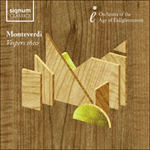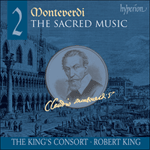The Marian motet ‘Exultent caeli’, for five voices and continuo, was published in the
Quarta raccolta de’ sacri canti (Fourth Collection of Sacred Songs, 1629) of Lorenzo Calvi, choirmaster of Pavia Cathedral as he styled himself on the title-page of his third collection (1626). Calvi’s book includes music by a number of able north Italian composers who had, to use his own words, ‘favoured him’ with compositions for inclusion in the anthology. In the source this appears to be a motet with two verses, and it has previously been performed as such. In fact, though, each verse refers to a different Marian Feast day and it is clear that only one should be sung at a time. The text of the second verse of Monteverdi’s motet identifies it as suitable for the Feast of the Annunciation (25 March). Monteverdi sandwiches the verse between two passages in triple time: the first is the five-part chorus of rejoicing that opens and closes the motet, the second a suave three-voice hymn to Mary which begins as a setting over the so-called ‘Chaconne Bass’, often used as an ostinato in music of the 1630s (Monteverdi himself used it for his setting of Rinuccini’s ‘Zefiro torna’, published in the
Scherzi musicali of 1632). In a note to the choirmaster Monteverdi states that the ‘Exultent caeli’ section can be performed with instruments doubling the voices.
from notes by John Whenham © 2004
Le motet marial « Exultent caeli » pour cinq voix et continuo est tiré de la
Quarta raccolta de’ sacri canti (Quatrième Livre de chants sacrés, 1629) de Lorenzo Calvi, chef de chœur de la Cathédrale de Pavie, comme il le soulignait lui-même dans la préface de son troisième Livre de 1626. Ce Quatrième regroupe des œuvres d’un certain nombre de compositeurs talentueux d’Italie septentrionale qui, selon ses propres termes, « lui ont fait la faveur » de lui offrir leurs compositions pour son anthologie. Cette pièce figure dans cette source sous la forme d’un motet de deux strophes, et c’est donc ainsi qu’elle a été exécutée. Chacune de ces strophes fait cependant référence à une fête mariale différente si bien qu’il apparaît clairement qu’on ne doit en chanter qu’une seule à la fois. Le texte de la seconde strophe de ce motet convient parfaitement à la fête de l’Annonciation (25 mars). Monteverdi a intercalé cette strophe entre deux passages en ternaire : le premier est un chœur de réjouissances à cinq voix qui ouvre et conclut le motet, le second une hymne suave à trois voix destinée à Marie qui débute sur une « basse de chaconne » souvent exploitée comme ostinato dans la musique des années 1630 (Monteverdi s’en servit pour mettre en musique « Zefiro torna » de Rinuccini publié dans ses
Scherzi musicali de 1632). Dans une note rédigée à l’intention du chef de chœur, Monteverdi indique que la section « Exultent caeli » peut être exécutée avec des instruments qui doublent les voix.
extrait des notes rédigées par John Whenham © 2004
Français: Isabelle Battioni
Die Marianische Motette „Exultent caeli“ für fünf Stimmen und Continuo wurde in der
Quarta raccolta de’ sacri canti (Vierte Sammlung von Geistlichen Gesängen, 1629) von Lorenzo Calvi, dem Kapellmeister des Doms zu Pavia (als solcher hatte er sich jedenfalls auf der Titelseite seiner dritten Sammlung von 1626 dargestellt), herausgegeben. In Calvis Buch finden sich Werke von mehreren fähigen norditalienischen Komponisten, die ihn, ihm selbst zufolge, mit Werken für diese Anthologie „beehrt hatten“. In der Quelle erscheint das Werk als Motette mit zwei Strophen und ist bisher auch als solche aufgeführt worden. Tatsächlich jedoch beziehen sich die beiden Strophen auf zwei verschiedene Marianische Festtage und es ist offensichtlich, dass sie dementsprechend einzeln aufzuführen sind. Der Text der zweiten Strophe von Monteverdis Motette bezieht sich auf Mariä Verkündigung (25. März). Monteverdi fügt die Strophe zwischen zwei Passagen im Dreiertakt ein: die erste ist der fünfstimmige, lobpreisende Chor, der die Motette eröffnet und beendet, und die zweite ist ein eleganter, dreistimmiger Hymnus an Maria, der über dem sogenannten „Chaconne-Bass“ beginnt (dieser Bass wurde in den 1630er Jahren viel als Ostinato verwendet und Monteverdi selbst setzte ihn in seiner Vertonung von Rinuccinis „Zefiro torna“ ein, die 1632 in den
Scherzi musicali veröffentlicht wurde). In einer Notiz an den Kapellmeister schreibt Monteverdi, dass das „Exultent caeli“ auch mit Instrumenten aufgeführt werden kann, die die Singstimmen verdoppeln.
aus dem Begleittext von John Whenham © 2004
Deutsch: Viola Scheffel


 Monteverdi: Vespers
Monteverdi: Vespers Monteverdi: The Sacred Music, Vol. 2
Monteverdi: The Sacred Music, Vol. 2
